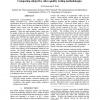Free Online Productivity Tools
i2Speak
i2Symbol
i2OCR
iTex2Img
iWeb2Print
iWeb2Shot
i2Type
iPdf2Split
iPdf2Merge
i2Bopomofo
i2Arabic
i2Style
i2Image
i2PDF
iLatex2Rtf
Sci2ools
VCIP
2003
2003
Comparing subjective video quality testing methodologies
International recommendations for subjective video quality assessment (e.g., ITU-R BT.500-11) include specifications for how to perform many different types of subjective tests. Some of these test methods are double stimulus where viewers rate the quality or change in quality between two video streams (reference and impaired). Others are single stimulus where viewers rate the quality of just one video stream (the impaired). Two examples of the former are the double stimulus continuous quality scale (DSCQS) and double stimulus comparison scale (DSCS). An example of the latter is single stimulus continuous quality evaluation (SSCQE). Each subjective test methodology has claimed advantages. For instance, the DSCQS method is claimed to be less sensitive to context (i.e., subjective ratings are less influenced by the severity and ordering of the impairments within the test session). The SSCQE method is claimed to yield more representative quality estimates for quality monitoring applicatio...
Communications | Double Stimulus | Stimulus Continuous Quality | Subjective Video Quality | VCIP 2003 |
| Added | 01 Nov 2010 |
| Updated | 01 Nov 2010 |
| Type | Conference |
| Year | 2003 |
| Where | VCIP |
| Authors | Margaret H. Pinson, Stephen Wolf |
Comments (0)

